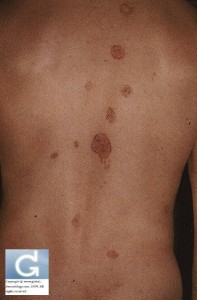Phototherapy
Phototherapy is the use of light in the treatment of a disease. It was noted in ancient times that psoriasis often improves with exposure to the sun. The sun’s ray consists mainly of visible light, ultraviolet “A” and ultraviolet “B” (UVA and UVB). In the treatment of psoriasis, two main types of phototherapy are used, UVB therapy and oral photochemotherapy called PUVA (Psoralen + UVA). UVB, which has a shorter wavelength than UVA, is used more often than PUVA. It is used without the ingestion of drugs. PUVA involves the ingestion of psoralen, a photoactive medication (furocoumarin) which makes the skin much more sensitive to UVA. Without psoralen, UVA is not active against psoriasis.
UVB Therapy
How does UVB therapy work?
- Its mechanism of action is not clearly understood but is probably via the alteration of activity in the skin cells by electromagnetic energy.
- The effect on the body’s own defence system may also play a role.
Is ultraviolet B (UVB) therapy effective in psoriasis?
- Yes, it is safe and effective treatment.
- UVB therapy helps most patients clear their psoriasis.
- About 20 to 30 treatments are required to achieve clearance when used with creams like tar or dithranol. More extensive psoriasis may require more prolonged treatment.
- Such clearance may last several months.
- Very severe psoriasis may not respond completely to UVB.
How do you receive UVB phototherapy?
- The treatment is prescribed by your doctor.
- Special light tubes emitting mainly UVB are used.
- UVB may be used with tar (called a modified Goekerman regimen), or with dithranol ( modified Ingram regimen) or with emollients ( an agent that moisturizes your skin).
Phototherapy procedure:
- A tar bath is recommended in the morning before the UVB therapy. This will hydrate the skin.
- Emollients are applied before receiving UVB.
- Protection of the eyes during treatment is important as direct exposure to the eyes can cause damage.
- The amount of UVB delivered to the body is gradually increased.
- Treatment may be given daily or a few days a week.
What are the side effects of UVB?
- The immediate effect is sunburn.
- After many years of continuous UVB treatment, the possible side effects include skin cancers and ageing of the skin.
- Short term therapy does not increase the risk of skin cancers.
- Skin cancers can be easily removed in the early stages.
PUVA
What is PUVA and how does it work?
- In PUVA, the medication, psoralen, makes the skin much more sensitive to long-wave ultraviolet light (UVA).
- The drug enables UVA to slow down cell division in the skin, helping to clear psoriasis.
Is PUVA therapy effective in psoriasis?
- Certainly. PUVA is usually recommended for patients who do not respond to UVB or to creams.
- About 70% to 90% of patients clear with PUVA.
- The number of treatments required is about 14 to 24, or more if the condition is extensive.
- This clearance with PUVA lasts from a few weeks to a year or more.
How do you use PUVA?
- The patient takes psoralen by mouth and 2 hours later, receives UVA light.
- Treatment is given 3-4 times per week. Once the skin lesions are cleared, periodic treatment (once a week) may be continued to maintain clearance.
- PUVA therapy must be carried out under medical supervision.
- A special cabinet is used to deliver the UVA and the skin’s reaction to the light is monitored carefully.
- The amount of UVA exposure is gradually increased until clearance is achieved.
What are the side effects of PUVA?
- Excessive PUVA may cause a deeper sunburn as UVA penetrates deeper into the skin than UVB. The patient must protect his skin from the sun on treatment days.
- Long term consequences of UVB include skin cancer and ageing of the skin. Skin cancers can be easily removed in the early stages.
- PUVA gives a deep tan which is cosmetically pleasing.
- If you are unwell during the treatment period, inform your doctor.
What are combination treatments?
- Both UVA and UVB may be used in combination with other medications like retinoid, eg. Etretinate (Tigason – a form of Vitamin A) or Methotrexate.
- Combination treatments increase effectiveness in clearing psoriasis.
- Re-PUVA is the combination of retinoid and PUVA:
- This is very effective for the treatment of generalized and severe, plaque psoriasis.
- It is generally recommended for those who fail to respond to UVB and PUVA.
- Retinoid (Tigason) enhances the effect of PUVA.
- In Re-PUVA, the number of PUVA treatments and the total UVA dosage is reduced significantly.
- Tigason is usually given 7 to 14 days starting PUVA.
Contributors:
Dr Christophe HSU – dermatologist. Geneva, Switzerland
National Skin Centre. Singapore
Category : benefits - Modifie le 11.28.2009Category : photoherapy - Modifie le 11.28.2009Category : photothérapie - Modifie le 11.28.2009Category : psoriasis - Modifie le 11.28.2009Category : risks - Modifie le 11.28.2009Category : risques et bénéfices - Modifie le 11.28.2009Category : traitement par les UV - Modifie le 11.28.2009Category : UV treatment - Modifie le 11.28.2009



